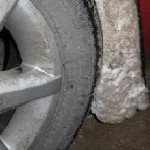Winter presents driving challenges. When it’s cold outside it’s tempting to idle your car to warm it up. What you need to know is that idling your car will only warm the engine, the rest of the moving parts are still cold. The best way to warm up your vehicle is to drive it.
To help speed up the warming up process, use your block heater (the most you need is 2 hours, not all night) and consider installing a winter front cover on your car to reduce the amount of cold air reaching the radiator. Using a piece of cardboard in front of the radiator is not recommended as it stops all air from reaching the radiator and should the weather warm up can cause your vehicle to overheat.
One of the most common concerns about driving a car before it warms up is the potential for the windows to fog up and make it difficult to see. There are two things that you can do to avoid this problem. Make sure that you clear away the snow from the air intake (in front of the windshield area) and open your window(s) a little. It might seem counter intuitive, but it will reduce the amount of moisture that condenses on your windows.
Driving in snow also increases fuel consumption because snow causes tires to slip and spin. The snow also adds to the drag placed against the vehicle’s motion. Remember to just take it easy, spinning and sliding will not only increase your fuel use, but the wear and tear on your vehicle as well. Even spinning your tires on ice causes wear on your tires.

Photo: Green Action Centre
Make sure to clear the snow off your car and clean out any snow and ice that builds up in your wheel wells. This extra weight will reduce your fuel economy. It’s also much safer when you can see clearly in all directions.
Don’t forget to check your tire pressure as well. In winter and especially during significant temperature swings, tire pressure can decrease significantly. Make sure that your valve stems have caps on them so that moisture does not freeze in the valve and allow the air to escape.
Specifically designed winter tires provide better traction and therefore can improve fuel economy under the right conditions. Want to know more about winter tires?




Recent Comments